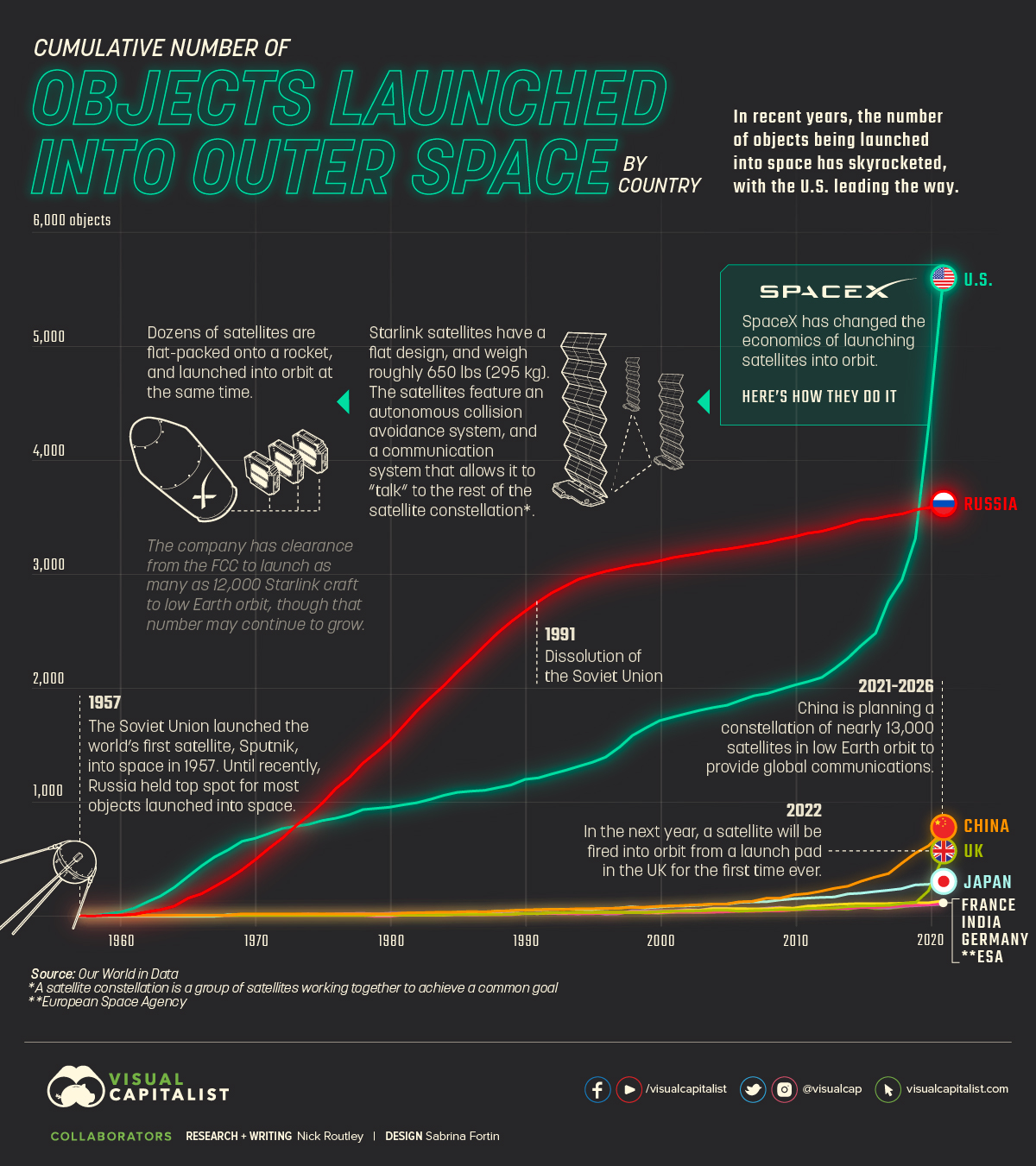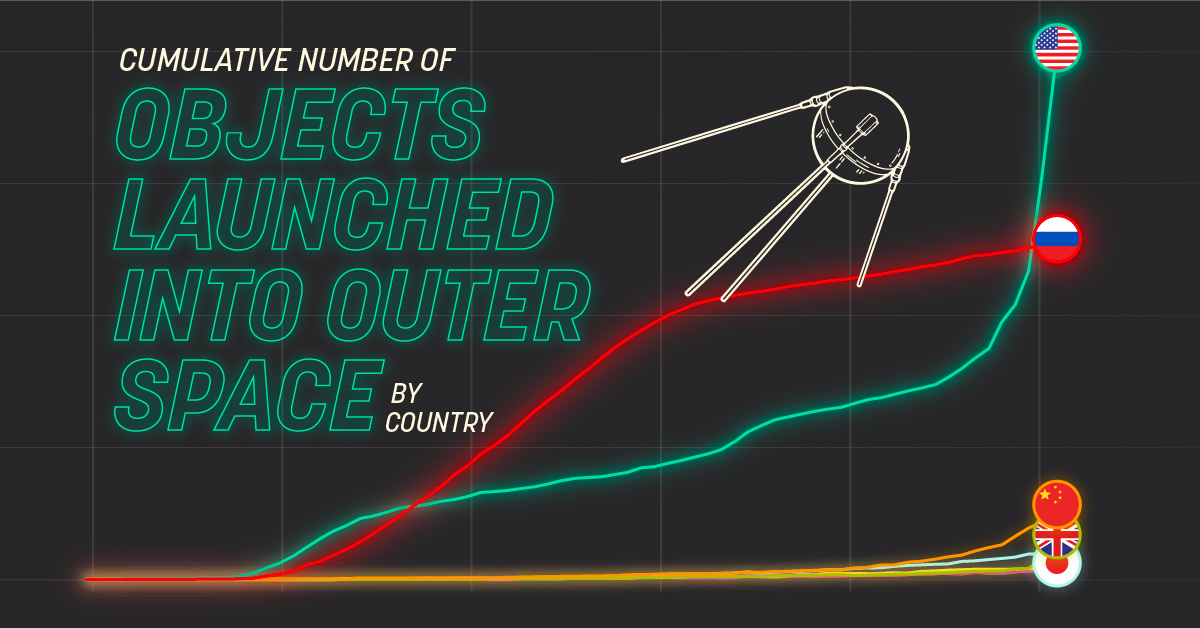Misc
Visualized: Which Countries are Dominating Space?

Visualized: Which Countries are Dominating Space
Believe it or not, there is a lot of stuff in space. In fact, our atmosphere is filled with more than 11,000 objects that have been launched since the foray into space began.
The Space Race started during the Cold War, and early on the Soviet Union dominated when it came to the amount of devices and objects launched into our atmosphere. But a few years ago, the U.S. took back that title with Elon Musk’s SpaceX helping lead the charge.
This visual, using data from Our World in Data, breaks down the amount of objects launched into space by country over time.
What Gets Launched Into Space?
What are the objects being sent into our atmosphere and why are they so important? Here’s a look at just a few:
- Satellites
- Crewed spacecraft
- Probes
- Space station flight equipment
Probes and landers like the Mars Rover, for example, have helped scientists explore other planets. Satellites provide us with everyday necessities like cell phone service, far reaching television signals, satellite imagery, and GPS.
As of late 2021, there were around 4,852 operational satellites in orbit—2,944 belonging to the United States. Here’s a quick look at what the U.S. uses its satellites for:
- Commercial: 2,516
- Military: 230
- Government: 168
- Civil: 30
Many satellites in orbit, however, are no longer functional. In fact, there is a lot of junk in space—according to NASA, there are over 27,000 pieces of space debris in orbit.
The Space Race, by Country
The venture into outer space began during the Cold War when the USSR launched the first satellite, Sputnik 1 in 1957. After this, the U.S. and Soviet Union entered a definitive competition between technological advancements and scientific exploration into space—an extension of the battle between political ideologies.
Few countries have come close in matching either the U.S. or Russia so far. Here’s a look at the cumulative number of objects different countries have launched into orbit and beyond.
| Rank | Country | Cumulative Number of Objects Launched into Space |
|---|---|---|
| #1 | 🇺🇸 United States | 5,534 |
| #2 | 🇷🇺 Russia | 3,611 |
| #3 | 🇨🇳 China | 731 |
| #4 | 🇬🇧 UK | 515 |
| #5 | 🇯🇵 Japan | 300 |
| #6 | 🇫🇷 France | 130 |
| #7 | 🇮🇳 India | 127 |
| #8 | 🇩🇪 Germany | 114 |
| #9 | 🇨🇦 Canada | 82 |
| #10 | 🇱🇺 Luxembourg | 53 |
| #11 | 🇮🇹 Italy | 52 |
| #12 | 🇰🇷 South Korea | 43 |
| #13 | 🇧🇷 Brazil | 39 |
| #14 | 🇦🇺 Australia | 36 |
| #15 | 🇧🇪 Belgium | 36 |
| #16 | 🇮🇱 Israel | 30 |
| #17 | 🇪🇸 Spain | 29 |
| #18 | 🇺🇾 Uruguay | 23 |
| #19 | 🇮🇩 Indonesia | 21 |
| #20 | 🇦🇷 Argentina | 20 |
| #21 | 🇸🇪 Sweden | 19 |
| #22 | 🇲🇽 Mexico | 18 |
| #23 | 🇸🇦 Saudi Arabia | 17 |
| #24 | 🇦🇪 United Arab Emirates | 17 |
| #25 | 🇹🇼 Taiwan | 17 |
| #26 | 🇫🇮 Finland | 17 |
| #27 | 🇹🇷 Turkey | 16 |
| #28 | 🇨🇭 Switzerland | 15 |
| #29 | 🇹🇭 Thailand | 14 |
| #30 | 🇳🇿 New Zealand | 14 |
| #31 | 🇳🇴 Norway | 14 |
| #32 | 🇳🇱 Netherlands | 13 |
| #33 | 🇩🇰 Denmark | 12 |
| #34 | 🇪🇬 Egypt | 9 |
| #35 | 🇰🇿 Kazakhstan | 9 |
| #36 | 🇲🇾 Malaysia | 9 |
| #37 | 🇱🇹 Lithuania | 9 |
| #38 | 🇺🇦 Ukraine | 8 |
| #39 | 🇵🇱 Poland | 8 |
| #40 | 🇻🇳 Vietnam | 7 |
| #41 | 🇵🇭 Philippines | 7 |
| #42 | 🇨🇿 Czechia | 7 |
| #43 | 🇩🇿 Algeria | 6 |
| #44 | 🇮🇷 Iran | 6 |
| #45 | 🇵🇰 Pakistan | 6 |
| #46 | 🇳🇬 Nigeria | 5 |
| #47 | 🇿🇦 South Africa | 5 |
| #48 | 🇭🇺 Hungary | 5 |
| #49 | 🇻🇪 Venezuela | 4 |
| #50 | 🇵🇪 Peru | 4 |
| #51 | 🇨🇱 Chile | 4 |
| #52 | 🇲🇦 Morocco | 3 |
| #53 | 🇦🇿 Azerbaijan | 3 |
| #54 | 🇬🇷 Greece | 3 |
| #55 | 🇪🇪 Estonia | 3 |
| #56 | 🇧🇾 Belarus | 3 |
| #57 | 🇧🇬 Bulgaria | 3 |
| #58 | 🇦🇹 Austria | 3 |
| #59 | 🇨🇴 Colombia | 2 |
| #60 | 🇪🇨 Ecuador | 2 |
| #61 | 🇰🇵 North Korea | 2 |
| #62 | 🇧🇩 Bangladesh | 2 |
| #63 | 🇵🇬 Papua New Guinea | 2 |
| #64 | 🇸🇰 Slovakia | 2 |
| #65 | 🇸🇮 Slovenia | 2 |
| #66 | 🇬🇭 Ghana | 1 |
| #67 | 🇪🇹 Ethiopia | 1 |
| #68 | 🇰🇪 Kenya | 1 |
| #69 | 🇷🇼 Rwanda | 1 |
| #70 | 🇦🇴 Angola | 1 |
| #71 | 🇬🇹 Guatemala | 1 |
| #72 | 🇨🇷 Costa Rica | 1 |
| #73 | 🇧🇴 Bolivia | 1 |
| #74 | 🇵🇾 Paraguay | 1 |
| #75 | 🇲🇳 Mongolia | 1 |
| #76 | 🇹🇲 Turkmenistan | 1 |
| #77 | 🇯🇴 Jordan | 1 |
| #78 | 🇶🇦 Qatar | 1 |
| #79 | 🇱🇰 Sri Lanka | 1 |
| #80 | 🇳🇵 Nepal | 1 |
| #81 | 🇧🇹 Bhutan | 1 |
| #82 | 🇱🇦 Laos | 1 |
| #83 | 🇱🇻 Latvia | 1 |
| #84 | 🇷🇴 Romania | 1 |
| #85 | 🇲🇨 Monaco | 1 |
| #86 | 🇵🇹 Portugal | 1 |
One important disclaimer here is that not all of these countries have orbital launch capabilities, meaning that although the satellite in space may belong to a certain country, that doesn’t mean that it was launched by said country. For example, the UK’s first launch in 1971 was out of Australia and France’s first launch took place in Algeria in 1965.
In total, around 86 countries have attempted some kind of entry into space. However, as of 2022, only 11 countries have the ability to send objects into space using their own launch vehicles, and only three—the U.S., Russia, and China—have ever launched people into outer space.
The Future of Space
With corporations beginning to take the lead in this new frontier, the landscape of space launches is changing. In 2019 Starlink, a constellation of satellites which provides 36 countries with internet access, was launched. With over 2,200 Starlink satellites in the sky and counting, SpaceX’s ultimate goal is global internet coverage; China is planning a similar venture.
Beyond useful satellites and scientific exploration, other potential space industries are emerging.
As one example, the business of commercial space tourism is no longer a futuristic concept. In late 2021, famous billionaire and founder of Virgin Galactic, Richard Branson flew briefly into space on a private flight. Jeff Bezos, having founded Blue Origin, followed shortly after.
Today, both Blue Origin and Virgin Galactic are licensed by the Federal Aviation Administration for passenger space travel. However, if you want to be launched into space, it will cost you around $250,000-$500,000.
Misc
How Hard Is It to Get Into an Ivy League School?
We detail the admission rates and average annual cost for Ivy League schools, as well as the median SAT scores required to be accepted.

How Hard Is It to Get Into an Ivy League School?
This was originally posted on our Voronoi app. Download the app for free on iOS or Android and discover incredible data-driven charts from a variety of trusted sources.
Ivy League institutions are renowned worldwide for their academic excellence and long-standing traditions. But how hard is it to get into one of the top universities in the U.S.?
In this graphic, we detail the admission rates and average annual cost for Ivy League schools, as well as the median SAT scores required to be accepted. The data comes from the National Center for Education Statistics and was compiled by 24/7 Wall St.
Note that “average annual cost” represents the net price a student pays after subtracting the average value of grants and/or scholarships received.
Harvard is the Most Selective
The SAT is a standardized test commonly used for college admissions in the United States. It’s taken by high school juniors and seniors to assess their readiness for college-level academic work.
When comparing SAT scores, Harvard and Dartmouth are among the most challenging universities to gain admission to. The median SAT scores for their students are 760 for reading and writing and 790 for math. Still, Harvard has half the admission rate (3.2%) compared to Dartmouth (6.4%).
| School | Admission rate (%) | SAT Score: Reading & Writing | SAT Score: Math | Avg Annual Cost* |
|---|---|---|---|---|
| Harvard University | 3.2 | 760 | 790 | $13,259 |
| Columbia University | 3.9 | 750 | 780 | $12,836 |
| Yale University | 4.6 | 760 | 780 | $16,341 |
| Brown University | 5.1 | 760 | 780 | $26,308 |
| Princeton University | 5.7 | 760 | 780 | $11,080 |
| Dartmouth College | 6.4 | 760 | 790 | $33,023 |
| University of Pennsylvania | 6.5 | 750 | 790 | $14,851 |
| Cornell University | 7.5 | 750 | 780 | $29,011 |
*Costs after receiving federal financial aid.
Additionally, Dartmouth has the highest average annual cost at $33,000. Princeton has the lowest at $11,100.
While student debt has surged in the United States in recent years, hitting $1.73 trillion in 2023, the worth of obtaining a degree from any of the schools listed surpasses mere academics. This is evidenced by the substantial incomes earned by former students.
Harvard grads, for example, have the highest average starting salary in the country, at $91,700.
-

 Real Estate2 weeks ago
Real Estate2 weeks agoVisualizing America’s Shortage of Affordable Homes
-

 Technology1 week ago
Technology1 week agoRanked: Semiconductor Companies by Industry Revenue Share
-

 Money1 week ago
Money1 week agoWhich States Have the Highest Minimum Wage in America?
-

 Real Estate1 week ago
Real Estate1 week agoRanked: The Most Valuable Housing Markets in America
-

 Business1 week ago
Business1 week agoCharted: Big Four Market Share by S&P 500 Audits
-

 AI2 weeks ago
AI2 weeks agoThe Stock Performance of U.S. Chipmakers So Far in 2024
-

 Misc2 weeks ago
Misc2 weeks agoAlmost Every EV Stock is Down After Q1 2024
-

 Money2 weeks ago
Money2 weeks agoWhere Does One U.S. Tax Dollar Go?


















